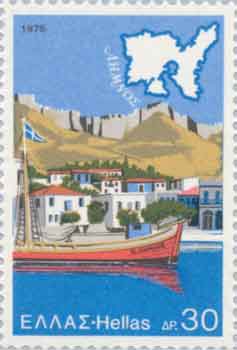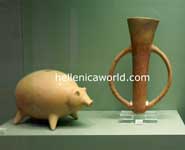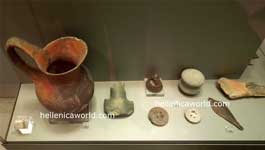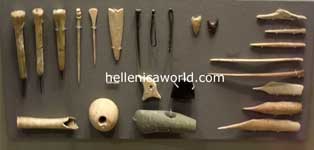.
Administrative Region : North Aegean
Regional unit : Limnos
Limnos or Lemnos (Greek: Λήμνος, Limnos) is an island of Greece in the northern part of the Aegean Sea. Administratively the island forms a separate municipality within the Lemnos peripheral unit, which is part of the North Aegean Periphery. The principal town of the island and seat of the municipality is Myrina.[1] At 477 km², it is the 8th largest island of Greece.

Geography
Lemnos is mostly flat (hence its more than 30 sand beaches), but the west, and especially the northwest part, is rough and mountainous (highest elevation: Mount Vigla, 470 m). The chief towns are Myrina, on the western coast, and Moudros on the eastern shore of a large bay in the middle of the island. Myrina (also called Kastro, meaning "castle") possesses a good harbour, which is in the process of being upgraded through construction of a west-facing sea wall. It is the seat of all trade carried on with the mainland. The hillsides afford pasture for sheep, and Lemnos has a strong husbandry tradition, being famous for its feta and melipasto cheeses, and for its yoghurt. Fruit and vegetables that grow on the island include almonds, figs, melons, watermelons, tomatoes, pumpkins and olives. The main crops are wheat, barley, sesame; in fact Lemnos was Constantinople's granary during Byzantine times. Lemnos also produces honey (from thyme-fed bees), but, as is the case with most products of a local nature in Greece, the produced quantities are little more than simply sufficient for the local market. Muscat grapes are grown widely, and are used to produce an unusual table wine that is dry yet has a strong Muscat flavor. Since 1985 the variety and quality of Lemnos wines have increased greatly. The island has an excellent airport, possessing a very long runway, capable of supporting Antonov carriers.
Mythic Lemnos
Myrina beach, Lemnos
For ancient Greeks, the island was sacred to Hephaestus, god of metallurgy, who— as he tells himself in Iliad I.590ff— fell on Lemnos when his mother, Hera who found him too ugly, hurled him headlong out of Olympus. There, he was cared for by the Sinties, according to Iliad or by Thetis (Apollodorus, Bibliotheke I:3.5), and there with a Thracian nymph Cabiro (a daughter of Proteus) he fathered a tribe called the Kaberoi. Sacred initiatory rites dedicated to them were performed in the island.
Hephaestus' forge, which was located on Lemnos, as well as the name Aethaleia, sometimes applied to it, points to its volcanic character. It is said that fire occasionally blazed forth from Mosychlos, one of its mountains. The ancient geographer Pausanias relates that a small island called Chryse, off the Lemnian coast, was swallowed up by the sea. All volcanic action is now extinct.
The earliest inhabitants are said to have been a Thracian tribe, whom the Greeks called Sintians, "robbers". The name Lemnos is said by Hecataeus to have been applied in the form of a title to Cybele among the Thracians. The worship of Cybele was characteristic of Thrace, where it had spread from Asia Minor at a very early period. Hypsipyle and Myrina (the name of one of the chief towns) are Amazon names, which are always connected with Asiatic Cybele-worship.
According to the epitome of the Bibliotheke traditionally attributed to Apollodorus (Epitome I:9), when Dionysus found Ariadne abandoned on Naxos, he brought her to Lemnos and there fathered Thoas, Staphylus, Oenopion, and Peparethus. Pliny the Elder in his Natural History (xxxvi. 13) speaks of a remarkable labyrinth in Lemnos, which has not been identified in modern times.
According to a Hellenic legend, the women were all deserted by their husbands for Thracian women, and in revenge they murdered every man on the island. From this barbarous act, the expression Lemnian deeds became proverbial among the Hellenes. according to Apollonius of Rhodes' Argonautica the Argonauts landing soon after found only women in the island, ruled by Hypsipyle, daughter of the old king Thoas. From the Argonauts and the Lemnian women were descended the race called Minyans, whose king Euneus, son of Jason and Hypsipyle, sent wine and provisions to the Achaeans at Troy. According to later Greek historians, the Minyans were expelled by a Pelasgian tribe who came from Attica.
The historical element underlying these traditions is probably that the original Thracian people were gradually brought into communication with the Greeks as navigation began to unite the scattered islands of the Aegean; the Thracian inhabitants were technologically primitive in comparison with the Greek mariners.
In another legend, Philoctetes was left on Lemnos by the Greeks on their way to Troy; and there he suffered ten years' agony from his wounded foot, until Odysseus and Neoptolemus induced him to accompany them to Troy. According to Sophocles, he lived beside Mount Hermaeus, which Aeschylus makes one of the beacon points to flash the news of Troy's downfall home to Argos.
History
Building at the hill of Poliochni, dating from the Early Bronze Age
Prehistory
The ruins of the oldest human settlement in the Aegean Islands found so far have been unearthed in archaeological excavations on Lemnos by a team of Greek, Italian and American archaeologists at the Ouriakos site on the Louri coast of Fyssini in Moudros municipality. The excavation began in early June 2009 and the finds brought to light, consisting mainly of high quality stone tools, are from the Epipaleolithic Period, indicating a settlement of hunters and gatherers and fishermen of the 12th millennium BC.
Lemnos
Poliochni on Lemnos
Early Bronze Age
3rd millenium B.C.

Pig-shaped vase and depas amphikypellon-cup


Clay jug, stone hammers and weights for fishing nets, bronze dagger

Bone and bronze tools and stone axes
A rectangular building with a double row of stepped seats on the long sides, at the southwest side of the hill of Poliochni, dates back to the Early Bronze Age and was possibly used as a kind of Bouleuterion.[CN]
In August and September 1926, members of the Italian School of Archaeology at Athens conducted trial excavations on the island.[2] The overall purpose of the excavations was to shed light on the island's "Etrusco-Pelasgian" civilization. The excavations were conducted on the site of the city of Hephaistia (i.e. Palaiopolis) where the Pelasgians, according to Herodotus, surrendered to Miltiades of Athens. There, a necropolis (ca. 9th–8th centuries BC) was discovered, revealing bronze objects, pots, and over 130 ossuaries. The ossuaries contained distinctly male and female funeral ornaments. Male ossuaries contained knives and axes whereas female ossuaries contained earrings, bronze pins, necklaces, gold-diadems, and bracelets. The decorations on some of the gold objects contained spirals of Mycenaean origin, but had no Geometric forms. According to their ornamentation, the pots discovered at the site were from the Geometric period. However, the pots also preserved spirals indicative of Mycenaean art. The results of the excavations indicate that the Early Iron Age inhabitants of Lemnos could be a remnant of a Mycenaean population and, in addition, the earliest attested refer to Lemnos is the Mycenaean Greek ra-mi-ni-ja, "Lemnian woman", written in Linear B syllabic script.[3] Professor Della Seta reports:[4]
The lack of weapons of bronze, the abundance of weapons of iron, and the type of the pots and the pins gives the impression that the necropolis belongs to the ninth or eighth century B.C. That it did not belong to a Greek population, but to a population which, in the eyes of the Hellenes, appeared barbarous, is shown by the weapons. The Greek weapon, dagger or spear, is lacking: the weapons of the barbarians, the axe and the knife, are common. Since, however, this population … preserves so many elements of Mycenaean art, the Tyrrhenians or Pelasgians of Lemnos may be recognized as a remnant of a Mycenaean population.
Lemnos stele, Lemnian (Etruscan) inscriptions discovered in a crypt
Antiquity
Homer speaks as if there were one town in the island called Lemnos. In Classical times there were two towns, Myrina (also called Kastro) and Hephaistia[5], which was the chief town. Coins from Hephaestia are found in considerable number, and various types including the goddess Athena with her owl, native religious symbols, the caps of the Dioscuri, Apollo, etc. Few coins of Myrina are known. They belong to the period of Attic occupation, and bear Athenian types. A few coins are also known which bear the name of the whole island, rather than of either city.
A trace of the pre-Greek Lemnian language is found on a 6th century inscription on a funerary stele, the Lemnos stele. Lemnos later adopted the Attic dialect of Athens.
Coming down to a better authenticated period, we find that Lemnos was conquered by Otanes, a general of Darius Hystaspis. But soon (510 BC) it was reconquered by Miltiades the Younger, the tyrant of the Thracian Chersonese. Miltiades later returned to Athens and Lemnos was an Athenian possession until the Macedonian empire absorbed it.
In 197 BC, the Romans declared it free, but in 166 BC gave it over to Athens which retained nominal possession of it until the whole of Greece was made a province of the Roman Republic in 146 BC. After the division of the Roman Empire in 395, Lemnos passed to the Byzantine Empire.
Middle Ages and Ottoman period
Medieval fortress in Skala
Further information: Byzantine Greece and Latinokratia
As a province of the Byzantine Empire, Lemnos belonged to the theme of the Aegean Sea, and was a target of Saracen raids.[6] Following the dissolution and division of the Empire after the Fourth Crusade, Lemnos was apportioned to the Latin Empire, and given as a fief to the Venetian Navigajoso family under the megadux Filocalo Navigajoso. Filocalo died in 1214, and was succeeded by his son Leonardo and his daughters, who partitioned the island into three fiefs between them. Leonardo retained the title of megadux of the Latin Empire and half the island with the capital, Kastro, while his sisters and their husbands received one quarter each with the fortresses of Moudros and Kotsinos. Leonardo died in 1260 and was succeeded by his son Paolo Navigajoso, who resisted Byzantine attempts at reconquest until his death during a siege of the island by the Byzantine admiral Licario in 1277. Resistance continued by his wife, but in 1278 the Navigajosi were forced to capitulate and cede the island back to Byzantium.
During the last centuries of Byzantium, Lemnos played a prominent role: following the loss of Asia Minor, it was a major source of food, and it played an important role in the recurring civil wars of the 14th century.[6] Following the Fall of Constantinople to the Ottomans in 1453, the island was added to the domain of the Gattilusi of Lesbos, but following the fall of the Despotate of the Morea in 1460, Sultan Mehmed II gave it as a domain to the last Despot, Demetrios Palaiologos.[6]
The island then fell under Venetian control. In 1476, the Venetians and the island's Greek inhabitants successfully defended Kotsinos against a Turkish siege, but the island was ceded to the Ottomans by the 1479 Treaty of Constantinople which ended the First Ottoman-Venetian War. During the Fifth Ottoman-Venetian War, following a major victory over the Ottoman fleet, the Venetians captured the island again on 20 August 1656, but the Ottomans recovered it barely a year later, on 31 August 1657, after a siege of 36 days. In 1770, Kastro was besieged by Count Orlov during the Russo-Turkish War of 1768–1774. The famous Sufi poet Niyazi Misri was exiled here for several years during the late 17th century.
Modern period
During the Russo-Turkish War of 1806–1812, Admiral Senyavin won the naval Battle of Lemnos off the coast. In on 8 October 1912, during the First Balkan War, Lemnos became part of Greece. The Greek navy under Rear Admiral Pavlos Kountouriotis took it over without any casualties from the occupying Turkish Ottoman garrison, who were returned to Anatolia. Moudros Bay became a forward anchorage for the Greek fleet, which enabled it to keep watch on the Dardanelles and prevent a foray by the Ottoman Navy into the Aegean. The Ottomans' two attempts to achieve this were beaten back in the battles of Elli and Lemnos. Thus the Ottomans were prevented from supplying and reinforcing their land forces in Macedonia by sea, a critical factor in the success of the Balkan League in the war.
During World War I, the Allies in early 1915 used the island to try to capture the Dardanelles Straits, some 50 km away. This was done chiefly by the British and largely through the enthusiasm of Winston Churchill. The harbour at Moudros was put under the control of British Admiral Rosslyn Wemyss, who was ordered to prepare the then largely unused harbour for operations against the Dardanelles.
The harbour was broad enough for British and French warships, but lacked suitable military facilities, which was recognized early on. Troops intended for Gallipoli had to train in Egypt; and the port found it difficult to cope with casualties of the ill-starred Gallipoli campaign. The campaign was called off in evident failure at the close of 1915. Moudros' importance receded, although it remained the Allied base for the blockade of the Dardanelles during the war.
In late October 1918, the armistice between the Ottoman Empire and the Allies was signed at Moudros.
After the Red Army victory in the Russian Civil War, many Kuban Cossacks, fled the country to avoid persecution from the Bolsheviks. A notable evacuation point was the Greek island of Lemnos where 18,000 Kuban Cossacks landed, though many later died of starvation and disease. Most left the island after a year.
Today the island of Lemnos (Limnos) has about 30 villages and settlements. The province includes the island of Agios Efstratios to the southwest which has some exceptional beaches and the only desert in Europe.
Climate
The climate in Lemnos is mainly Mediterranean. Winters are generally mild, but there will be a snowfall occasionally. Strong winds are a feature of the island, especially in August and in winter time, hence its nickname "the wind-ridden one" (in Greek, Ανεμόεσσα). The temperature is typically 2 to 5 degrees Celsius less than in Athens, especially in summertime.
Municipality
The present municipality Lemnos was formed at the 2011 local government reform by the merger of the following 4 former municipalities, that became municipal units:[1]
Atsiki
Moudros
Myrina
Nea Koutali
Municipality Limnos(Seat: Μύρινα, η) |
|---|
| Municipal unit Ατσικής |
| Community Αγίου Δημητρίου |
| Agios Dimitrios (Άγιος Δημήτριος, ο) |
| Community Atsiki |
| Atsiki (Ατσική, η) |
| Propouli (Προπούλιον, το) |
| Community Varos |
| Αερολιμήν, ο |
| Varos (Βάρος, το) |
| Community Dafni |
| Dafni (Δάφνη, η) |
| Community Karpasi |
| Karpasi (Καρπάσιον, το) |
| Community Katalakko |
| Κατάλακκον, το |
| Σεργίτσι, το (νησίς) |
| Community Sardes |
| Sardes (Σαρδαί, αι) |
| Municipal unit Moudros |
| Municipal Community Moudros |
| Κουκονήσιο, το (νησίς) |
| Moudros (Μούδρος, ο) |
| Community Kalliopi |
| Kalliopi (Καλλιόπη, η) |
| Community Kaminia |
| Βοροσκόπος, ο |
| Kaminia (Καμίνια, τα) |
| Community Kontopouli |
| Agios Alexandros (Άγιος Αλέξανδρος, ο) |
| Άγιος Θεόδωρος, ο |
| Kontopouli (Κοντοπούλιον, το) |
| Community Lychna |
| Anemoessa (Ανεμόεσσα, η) |
| Lychna (Λύχνα, τα) |
| Community Panagia |
| Κορτισώνας, ο |
| Panagia (Παναγία, η) |
| Community Plaka |
| Plaka (Πλάκα, η) |
| Community Repanidi |
| Kotsinas (Κότσινας, ο) |
| Repanidi (Ρεπανίδιον, το) |
| Community Roussopouli |
| Ρουσσοπούλιον, το |
| Community Romano |
| Romano (Ρωμανόν, το) |
| Community Skandali |
| Skandali (Σκανδάλιον, το) |
| Community Fysini |
| Αγία Σοφία, η |
| Fisini (Φισίνη, η) |
| Municipal unit Myrina |
| Municipal Community Myrina |
| Myrina (Μύρινα, η) |
| Community Thanos |
| Thanos (Θάνος, το) |
| Paralia Thanous (Παραλία Θάνους, η) |
| Community Kaspakas |
| Άγιος Ιωάννης, ο |
| Gali (Γάλη, η) |
| Kaspakas (Κάσπακας, ο) |
| Λιμενάρια, τα |
| Community Kornos |
| Kornos (Κορνός, ο) |
| Ψύλλοι, οι |
| Community Platy |
| Άγιοι Ανάργυροι, οι |
| Παραλία Πλατέος, η |
| Πλαγίσος Μώλος, ο |
| Platy (Πλατύ, το) |
| Municipal unit Nea Koutali |
| Community Agkaryones |
| Agkaryones (Αγκαρυώνες, οι) |
| Community Kallithea |
| Kallithea (Καλλιθέα, η) |
| Community Kontias |
| Kontias (Κοντιάς, ο) |
| Community Livadochori |
| Livadochori (Λιβαδοχώρι, το) |
| Poliochni (Πολιόχνη, η) |
| Community Nea Koutali |
| Nea Koutali (Νέα Κούταλη, η) |
| Community Pedino |
| Αλογονήσιο, το (νησίς) |
| Βουνάρια, τα |
| Νέο Πεδινό, το |
| Πεδινόν, το |
| Community Portiano |
| Πορτιανόν, το |
| Community Tsimandria |
| Καστριά, τα (νησίς) |
| Κόμπιον, το (νησίς) |
| Τσιμάνδρια, τα |
Socio-economic data
In 2001 the island had 12,116 regular dwellings, of which 65% were stone-built, and 90.2% had pitched roofs made of red tiles (source: 18.3.2001 Census, National Statistical Service of Greece).
The island's economically active population in 2001 was 6,602. Of them, 12% were employers, 20.5% self-employed, 55.3% wage-earners, 7.1% unpaid, auxiliary family members, and 5.1% did not declare line of occupation. Of the economically active population, 17.9% worked in agriculture, 5.3% in light manufacturing, 11% in construction, 6.7% in hotels & restaurants, and the rest in other lines of business (source: 2001 Census, National Statistical Service of Greece).
Notable people
Alcamenes (5th century BC); sculptor
Ilias Iliou (1904–1985); politician, leader of United Democratic Left
Rallis Kopsidis (born 1929); painter, writer
See also
Lemnian
Armistice of Mudros (or Moudros)
References
^ a b Kallikratis law Greece Ministry of Interior (Greek)
^ A short account of their excavations appeared in the Messager d'Athènes for January 3, 1927.
^ Palaeolexicon, Word study tool of ancient languages
^ Heffner, Edward H. "Archaeological News: Notes on Recent Archaeological Excavations and Discoveries; Other News" (July–December 1926). American Journal of Archaeology. Vol. 31, No. 1 (January 1927), pp. 99–127, especially pp. 123–124.
^ "Hephaistia". Pleiades, directory of Ancient Places.
^ a b c Kazhdan, Alexander, ed (1991). Oxford Dictionary of Byzantium. Oxford University Press. p. 1205. ISBN 978-0-19-504652-6.
Sources
This article incorporates text from a publication now in the public domain: Chisholm, Hugh, ed (1911). Encyclopædia Britannica (11th ed.). Cambridge University Press.
Greece :
A - B - C - D - E - F - G - H - I - J - K - L - M -
N - O - P - Q - R - S - T - U - V - W - X - Y - Z
| Ancient Greece
Science, Technology , Medicine , Warfare, , Biographies , Life , Cities/Places/Maps , Arts , Literature , Philosophy ,Olympics, Mythology , History , Images Medieval Greece / Byzantine Empire Science, Technology, Arts, , Warfare , Literature, Biographies, Icons, History Modern Greece Cities, Islands, Regions, Fauna/Flora ,Biographies , History , Warfare, Science/Technology, Literature, Music , Arts , Film/Actors , Sport , Fashion --- |
Retrieved from "http://en.wikipedia.org/"
All text is available under the terms of the GNU Free Documentation License


